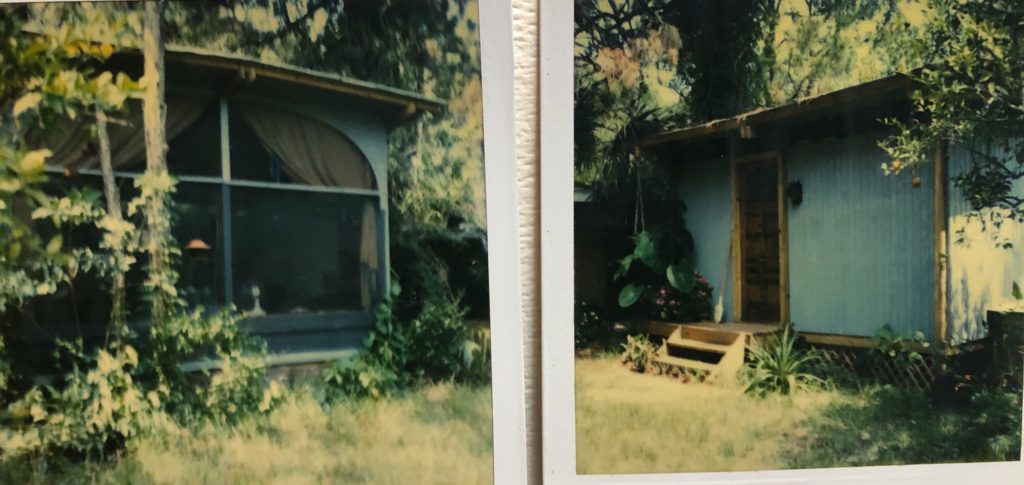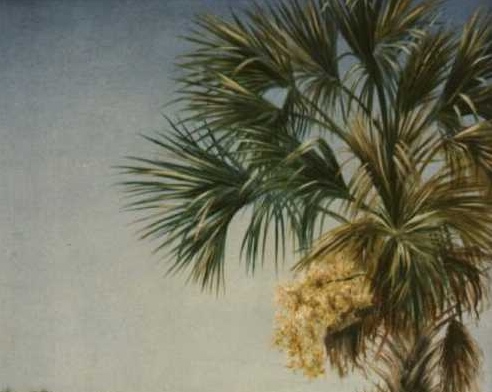Building A Studio
68 East Av.
In the mid-1980’s I rented a small house in Florida on three acres. Because I was cramped for painting space, the owner allowed me to build a studio in the middle of the garden. Fortunately, with Florida’s mild climate, I was able to build a studio for $1000. including paint, stain, and floor covering.
Also, I designed the structure with as little sawing as possible, putting it up in less than two weeks.

The Setting
The finished structure was 12′ by 16’with ceilings 12′ high and had a sloped roof.
It had a big screened opening 14′ by 11′, which faced north, and a view of pine woods and palmetto. To the south of the studio was a neglected citrus orchard that produced a small quantity of exceptionally delicious oranges, tangerines, and grapefruit. These were exotic varieties whose provenance had been lost with the departure of the original owner.
The 14′ by 11; opening could be closed relatively snugly in lousy weather by plastic drops fitted into slots in the frame.
Cabbage Palm next to my studio at 68 East Avenue, detail from a 6"x12" Oil on wood panel

Cooling and Heating
Air conditioning was not feasible as there only was electricity to run a couple of fans and the lights I needed to work. However,the studio was cooled and heated by the sun. To demonstrate, during the day, the sun would warm the outside walls and the warm air in the wall cavity, creating a convection current drawing in cooler air. Because openings near the floor where the baseboard would have been on an ordinary house, let air into the cavity and warm air went out side through clerestory openings at the top of the wall. There was a pleasant movement of air as long as the sun was hitting the building. Although there were a few weeks at the end of the summer when the evenings were unpleasantly humid, hot, and uncomfortable, even with fans. In contrast, in the winter, when it was cold, I could close the clerestory openings by ropes attached to hinged wood panels, and heat created in the walls would warm the building. By 9:30 or 10 am. the studio would be toasty and warm. Nevertheless, I had a kerosene heater for the chilly evenings.
A Moth Invasion
The studio and the setting were like heaven except for a problem with moths at night. Light from the studio was a beacon to them. The clerestory openings which I left open to cool the studio made the problem worse. Moths would cover the screens. Every time the door opened, a few moths would flutter into the studio and head to the light spots on my paintings and get stuck in the wet paint. Picking moths off the canvas was a persistent problem. I attempted many solutions, including flypaper, curtains, and sprays. Nothing workedL
Introducing Nephila Clavipes, The Florida Banana Spider
Then I had the idea of using spiders. They love bugs, so why not solve the problem with nature. I decided to try the golden silk spider or the banana spider (Nephila clavipes). Unlike the South American brown banana spider, which is very poisonous. Nephila clavipes is not deadly, doesn’t often bite, and grows large, up to five inches. It can have a body as thick as a little finger, so it needs to eat a lot. These spiders make humongous webs of very strong sulfur yellow silk that can stretch 10 feet or more. I had walked into or bounced off of many a web walking in the garden. I found a small banana spider near the studio, a female I brought back to my studio.
Picking up the outside lines of her web I carried her into my studio. I attached the web to the top of my easel and a hanging lamp. She quickly made herself at home and repositioned the web to a position that better trapped the moths. Only snap or click beetle fireflies were able to get out of her web. They would just snap their backs and pop out of the web with one or two snaps. Their hard casing was great in avoiding her sting. I never saw one become dinner.
Living With a Spider
The problem was solved. The spider was happy, well-fed, and grew to be huge, and best of all, my paintings were free of moth scales, wings, legs, and other body parts.
I quickly got used to her company. With a spider hanging over my head, it was easy to get to know her habits and routines as I was painting. She was tidy to an extreme, dusting and cleaning the web constantly. She repaired the damage caused by insect struggles during their capture. The web quickly returned to perfect symmetry. Cleaning and repairing the web meant she would eat the damaged part, letting dust and dirt fall to the floor and start over. I became used to her presence and got used to her routine. After having her in my studio for a while, I noticed the web getting torn, dusty, and neglected.
Was she ill or dying? As the web became neglected, she became less and less mobile and gradually just stayed at the center of the web, looking shabby and frayed. Finally, she stopped eating and sat almost motionless. I was worried and sad about what I thought was a serious problem. Suddenly she was twice her size. She had molted.
Molting
She had a new body, her fur, body markings, and sheen were beautiful. She stayed immobile for a couple of days at the center of the web then went back to her routine housekeeping. The unique part of her molting was that she kept her old casing or exoskeleton. She hung it up at the side of the web like a piece of clothing she might wear again if she lost weight. Every time she molted, she would hang her old suit next to the previous ones. It was not unusual to see three suites hanging neatly next to one another. She would always be careful when she would remake her web to rehang her old suits back up as they were before.
Spider Love
Despite the studio being totally enclosed, a male spider found its way into the studio and up onto her web. Much smaller than the female, he stayed quiet on the edge and opposite of his future mate. At first, I did not realize he was the same species and because he was so furtive and would sneak around the web and steal food when she was not aware of his presence. I learned this was a safety measure to avoid becoming dinner. He did not have a web of his own and was totally incompetent in supporting himself. Later, when she died, he made a vain attempt to make a web. These few haphazard strands could never have caught anything.
I like to think that she was not aggressive towards him, just totally unaware he was not just another insect. She was so fast to sting and paralyze her pray that she would not have noticed that he had just killed her husband. He fed when his wife had the fortune of two insects being caught in the web simultaneously. She would paralyze the first, tie it up in silk, and race off secure the second. The moment she left the first, he would scramble to her first kill and have dinner while ensnared the second. His meals were always furtive, and he was quick to flee if he sensed her approach.
Spider sex
Sex was always confined to the time when she molted. When she first emerged from the old casing, her new exoskeleton had not hardened, and she was vulnerable and would stay in the center of the web. The male would come to hold her in his arms(legs) until her new armor hardened. Once she started to get her strength back, he would leave her and retreat to the edge of the web again. She usually did not react to his movements, but he could sense her coming and dart away to safety if she did. His love was only fulfilled when she molted.
Babies
She became pregnant. Near delivery time, she left the web, and in a far corner of the studio, she proceeded to make a nest or a ball of yellow silk to deposit her eggs. When they hatched, they formed a web or curtain of hundreds of baby spiders. Too many spiders to have in my studio. So I moved the whole nursery to the outside and hung it on a few nearby tree branches. They lived there happily and gradually drifted off to other parts of the garden. Banana spiders only live for a year, and I picked a few of her offspring to stay in the studio, keeping my paintings free from the moths. So, over four years, I had one of the original spiders’ offspring in my studio.
Trees that Rain
Florida winters are dry, months without significant rain are not unusual. Yet nights can be foggy and misty. The first foggy night that I was in my studio, I was sure I heard rain. The studio did not have windows or insulation, and every sound from the outside was easily audible. Rain was unusual, so I stepped outside to see the rain. It was not raining. The sound came from the tall slash pines. The sound of rain was water was dripping from the trees. The Florida pine, known as the turpentine tree or slash pine, has very long needles. The long needles bend down toward the earth. The mist was condensing on the needles and dripping to the ground. The pines’ roots come to the surface, growing into the leaf litter to catch these drops before evaporating. The trees were self-watering. As a side note, there is a tree from Australia Australian called but not a pine with similar long needles and root structure. Called an Australian Pine, it does very well in Florida.